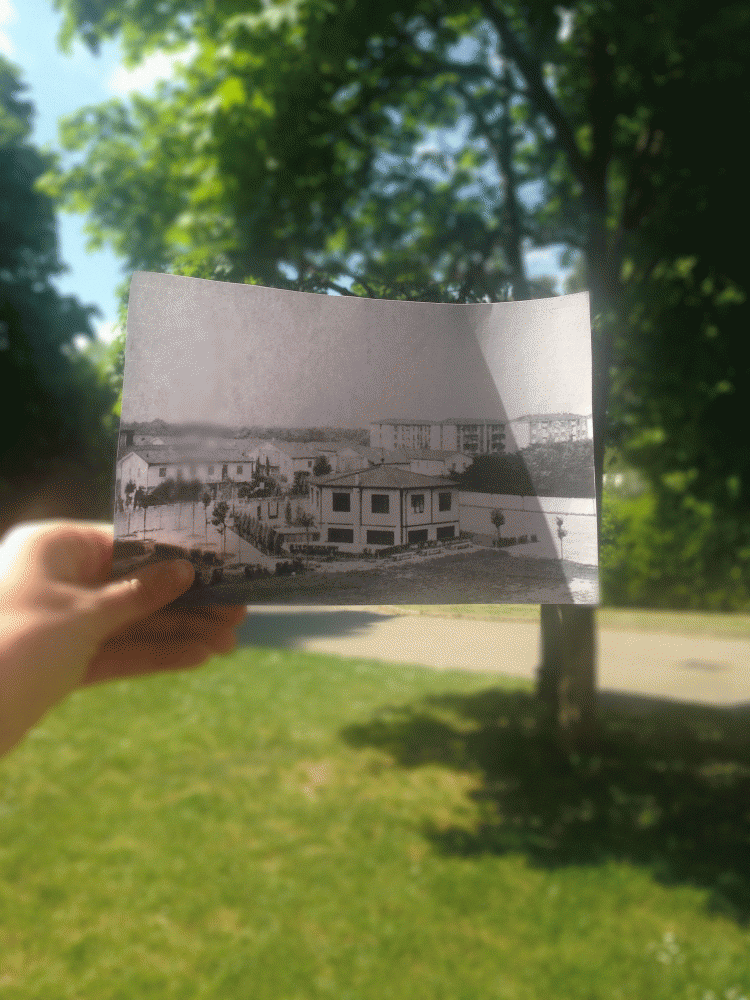
Il quartiere San Paolo prese forma a partire tra gli anni ’60 e ’70 del ‘900, in particolare vi era un progetto che comprendeva l’oratorio, la chiesa e l’asilo. Nella foto sopra potrete vedere come il centro fosse sviluppato attorno all'”Esagono”, chiamato così per la struttura poligonale a forma di esagono.
Il progetto comprendeva la costruzione di una grande Chiesa che potesse soddisfare tutte le esigenze degli abitanti di questo piccolo quartiere. Inizialmente, infatti, era composto da poche abitazioni, in particolare le case popolari in via Abruzzi erano l’epicentro della vita di “San Paolo”.

Come potrete notare dalla foto sopra, il progetto prevedeva un centro capace di soddisfare le esigenze dai più piccoli ai più anziani, infatti, i campi da gioco di tennis, pallavolo e basket erano un’ottima novità per introdurre le attività sportive nel quartiere appena nato. In più, la chiesa doveva rispondere ad un ingente numero di credenti, che aumentava costantemente negli anni; purtroppo, quest’ultima non fu realizzata secondo il progetto, ma il suo attuale collocamento è tra via Liguria e via Gramsci sotto altre spoglie, chiamata chiesa di “San Giovanni”.

La costruzione della Chiesa venne destinata nella parte sottostante l’edificio “Esagono” per dare più servizi ai cittadini del quartiere, oggi di notevole importanza per gli anziani che si dedicano alla vita religiosa.
Ma il quartiere “San Paolo” non è solo oratorio o chiesa, poiché, nel giro di dieci anni (dagli inizi del 2000 a oggi) si è popolato e animato, grazie alla costruzione di molti palazzi, ad esempio in via Liguria, e all’introduzione di supermercati, quali U2 e Esselunga, che hanno contribuito all’aumento dei servizi nel quartiere.

Non solo, anche l’inserimento di scuole elementari (Deledda e Toscanini), medie (Bonvesin de La Riva, distaccamento) pubbliche e il complesso “Tirinnanzi” con scuola media e superiore, hanno favorito la possibilità, per le famiglie, di abitare in armonia e tranquillità nel quartiere. Un’unica problematica: la troppa tranquillità e poca sicurezza ha favorito lo sviluppo di furti e danni a discapito dei cittadini, purtroppo, sempre più minacciati dagli accampamenti ROM.
More photos are on my pinterest page: https://it.pinterest.com/deborahcorno/
The San Paolo district took shape starting in the 60s and 70s of the ‘ 900 , in particular there was a project that included the oratory , the church and Asylum . In the picture above you can see how the center was developed around all ‘ ” Hexagon “, so called for the polygonal structure in the shape of hexagon.
The project included the construction of a large church that would meet all the needs of the inhabitants of this small neighborhood . Initially , in fact , it consisted of a few houses, including low-income homes in via Abruzzi were the epicenter of the life of ” St. Paul”
As you can see from the picture above , the project provided a center able to meet the needs from the smallest to the oldest, in fact, from the game of tennis, volleyball and basketball were a great novelty for introducing sport in the newborn district. In addition, the church had to respond to a large number of believers , who constantly increased over the years; unfortunately, it was not realized according to the plan, but his current placement is between Via Liguria and Via Gramsci in a different guise, church called “San Giovanni”.

The construction of the church was designed in part below the ” Hexagon ” building to provide more services to the citizens of the neighborhood , of considerable importance today for seniors who are dedicated to the religious life .
But the ” San Paolo ” neighborhood is not only oratory or church , because in the space of ten years ( since the early 2000s to the present) has been populated and animated , thanks to the construction of many buildings , for example in via Liguria , and all ‘ introduction of supermarkets , such as U2 and Esselunga , which contributed to the increase of services in the neighborhood.
Not only that , even the inclusion of primary schools (Deledda and Toscanini) , medium (Bonvesin de La Riva , detachment) public and ” Twice ” complex with middle and high school , favored the possibility for families to live in harmony and tranquility in the neighborhood. One problem: too much peace and little security has encouraged the development of theft and damage to the detriment of citizens , unfortunately , increasingly threatened by ROM camps.
